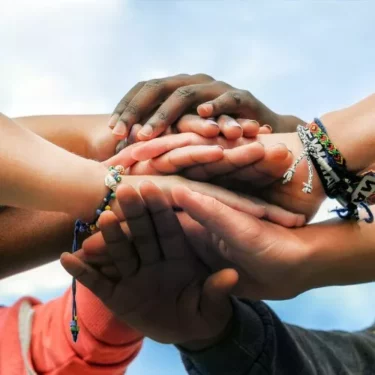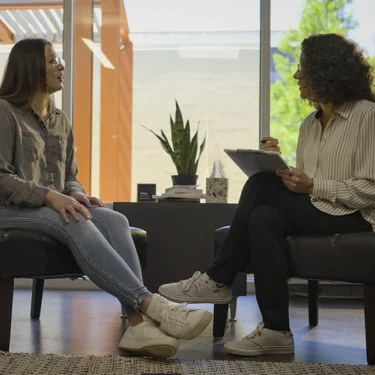As youth mental wellbeing trends downward, the need for communities to engage youth to find ways to promote mental wellbeing is more important than ever. To see how our CONNECTED program is making a difference in community-based mental health organizations, we spoke with Kristi Slette, executive director of the Whatcom Family & Community Network, one of the five organizations we partnered with to help design and create strategies to improve access to mental health supports.
What inspired your organization to get involved with CONNECTED?
“Prior to CONNECTED, our main method of reaching out to youth was through M.A.D. H.O.P.E. (Making A Difference Helping Other People Everywhere), a youth suicide prevention program. We would send adult trainers to county schools to talk to students about youth suicide prevention and mental wellbeing. We had always reinforced M.A.D. H.O.P.E. as a peer-to-peer program, but there were always barriers we faced when it came to reaching and recruiting youth. So, when we heard about the CONNECTED initiative and a new model for engaging with youth, we were interested in seeing what we could do better when trying to connect with them.”
What was one of the first things you learned from CONNECTED?
“As we started to engage with youth more through the CONNECTED model, we learned that youth mental wellbeing action could look a lot of different ways. We transformed from M.A.D. H.O.P.E. being just a curriculum taught in middle and high schools, to the program being a ‘container’ for youth mental wellbeing that could hold all sorts of different ideas for youth mental health engagement. Youth could come into that ‘container’ and manifest what they thought would work for them and their friends in a variety of ways – from quick coffee chats to art shows and gaming tournaments, with each event revolving around different aspects of youth mental wellbeing.”
How has CONNECTED impacted your youth mental wellbeing efforts?
“CONNECTED gave us the idea to involve youth in our community capacity building. We started a group called the Whatcom Youth Behavioral Stakeholder Gathering because we noticed a lack of dialogue between our youth and behavioral health providers, clinical providers, insurance providers and social services. We invited people across the entire continuum of care into a space where we could start to talk about issues in the behavioral health system.
“We wanted to find what was going well, gaps in mental health services, things we could leverage to solve problems and services that needed to be developed. With all of the work the community has done on this issue, youth mental wellbeing has become one of the top three countywide priorities for our five year-community health improvement plan. Now, we’re working on larger public efforts to address youth mental wellbeing, like the Healthy Whatcom Effort.”
What has been one of your biggest takeaways from CONNECTED to date?
“One of the pivotal learnings from CONNECTED was the youth engagement ladder tool. It gave us a new perspective on how we could have youth engage with the organization, along with a guide on how youth could engage in different projects at different levels of the organization. It helped us determine where the youth and adults belonged on each project, who should drive the project and whether youth would be receptive toward the project. This allowed us to manage projects better and communicate more clearly with youth, so that we could better support their needs.”
How has your organization benefited from your involvement with CONNECTED?
“Since engaging young people, M.A.D. H.O.P.E. has become a safe community space for youth. They can now come to us about what they think would matter to their peers in order to make a difference around increasing resilience and hope in the face of adversity; specifically, adversities that distress them emotionally and mentally. M.A.D. H.O.P.E. is now a container for youth ideas where they can manifest themselves in the community with adult and organizational support – that’s a tremendous change!”
What has engaging youth and creating youth-adult partnerships taught you?
“As adults in leadership roles, we have to trust ourselves to give up control when it comes to involving youth in the promotion of their own mental wellbeing. There’s a balance between emboldening and giving leadership opportunities and burdening and overwhelming youth. We want to offer opportunities for youth to engage with the organization, but we also don’t want to make their life harder by putting all of this adult responsibility on them. We have to learn how to give space to youth but not abandon them as we provide resources and constraints that will allow them to grow.”
Why should organizations be interested in raising the voice of young people?
“Young people are amazing human beings. As we work on equity in communities, we need to learn from youth who have lived experience, so that we can make changes that matter to them. The world that youth and adults live in can look very different. Only youth can speak their truth to us and tell us how the systems in place are impacting them and what we can do to make these systems better. Youth know their peers. They know how people are responding to things emotionally, intellectually and physically. Without taking advantage of what youth have to offer, we are going to miss the mark and invest in strategies that are not as effective as they could have been with guidance from youth.”
Guest Author
Marketing and Communications Intern
National Council for Mental Wellbeing



